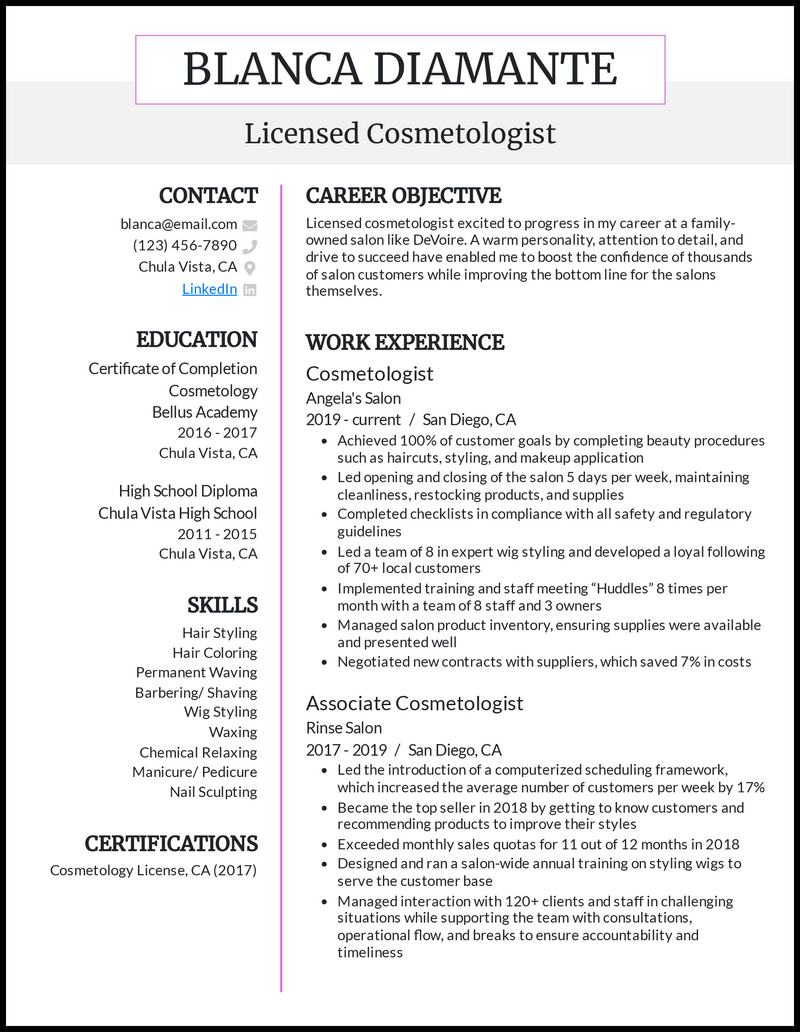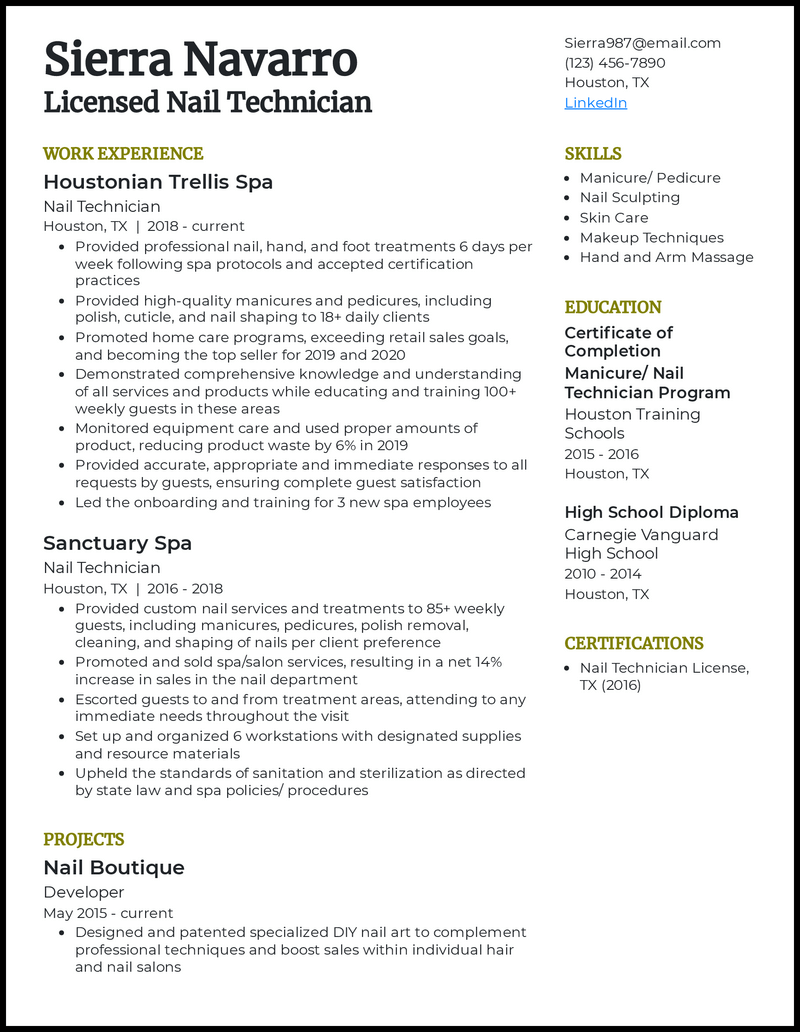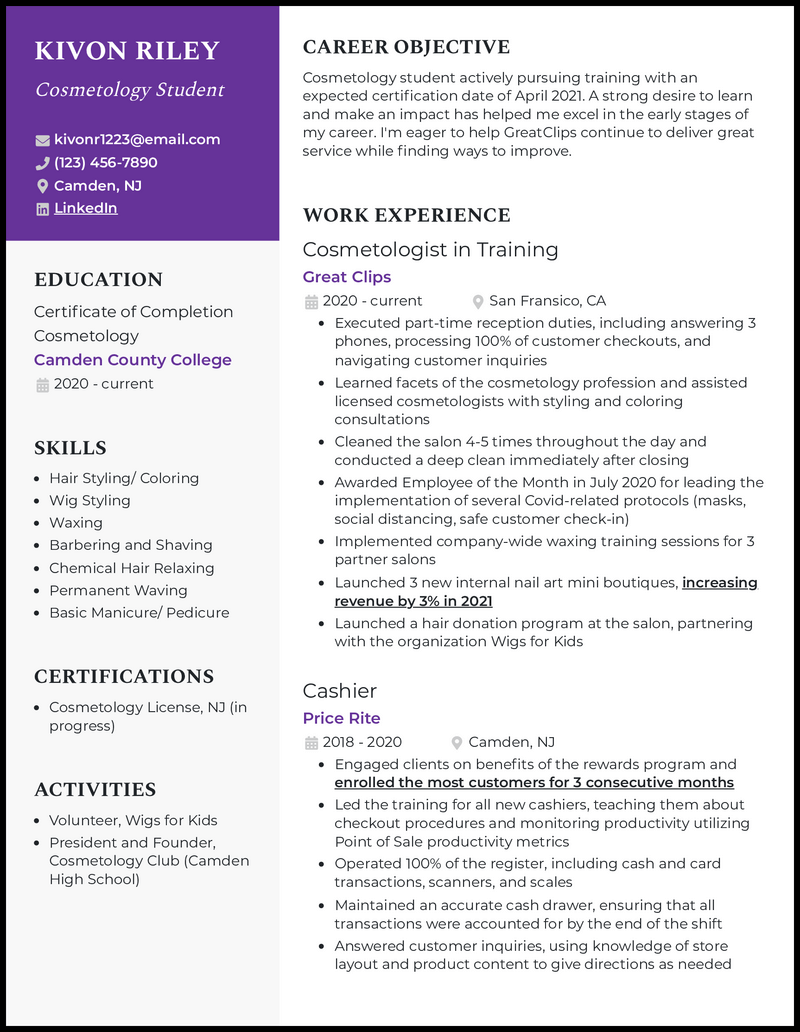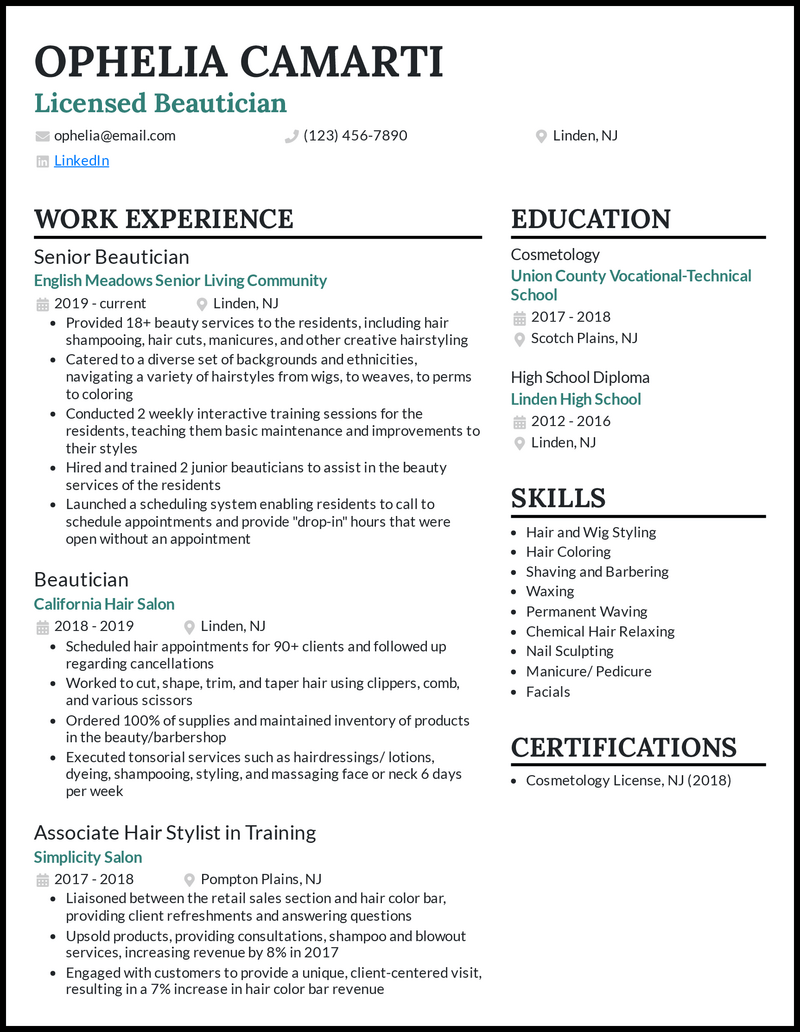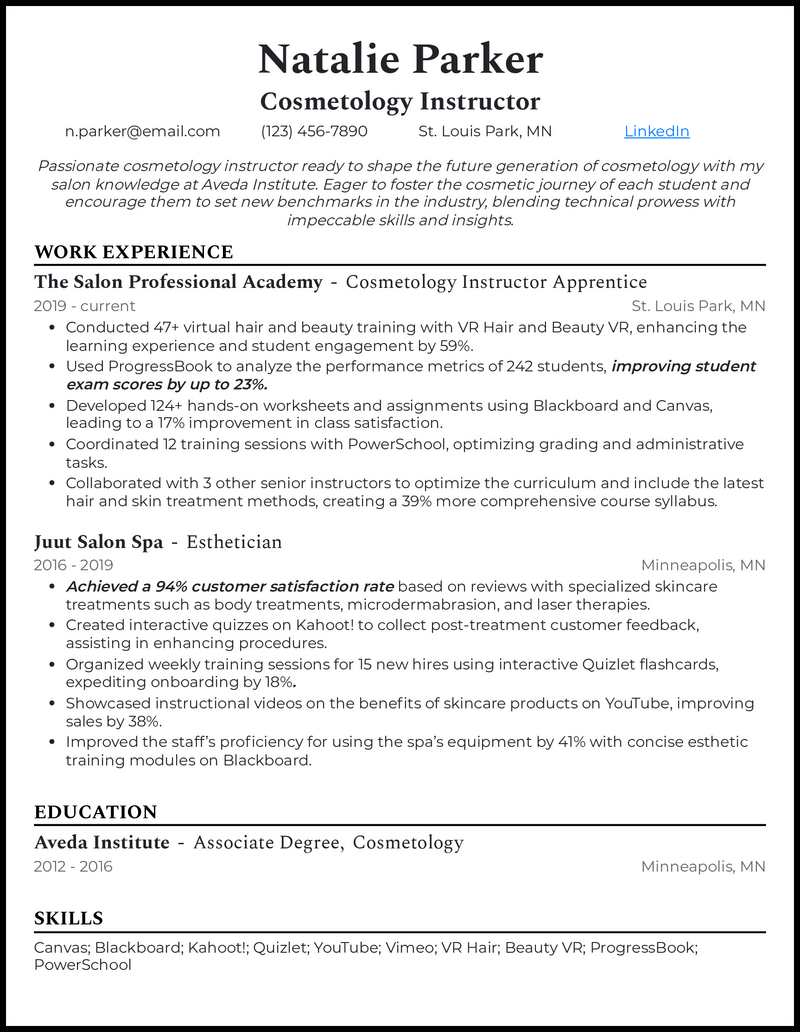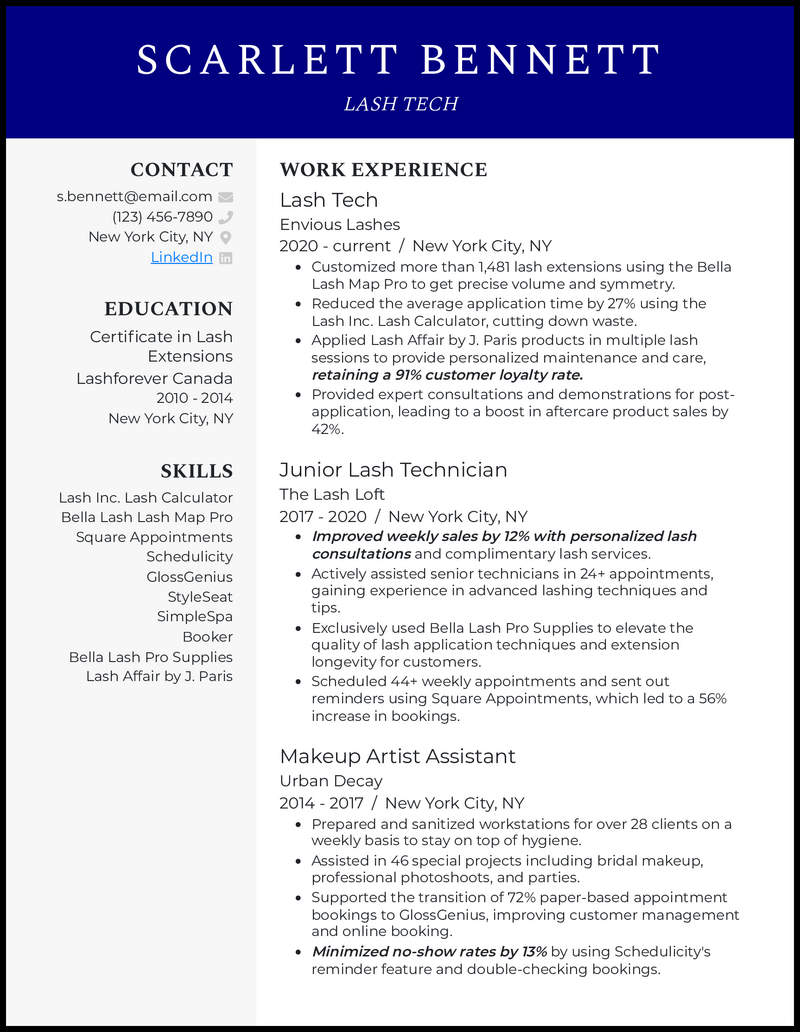
Cosmetology





Best for careers that encourage creativity
Resume Builder
Like this template? Customize this resume and make it your own with the help of our Al-powered suggestions, accent colors, and modern fonts.
Crafting the perfect cosmetology resume means blending creativity with professionalism so hiring managers see your skills and style instantly.
Our guide on writing resumes and following best resume practices will help you stand out in a competitive beauty industry.
This guide shares:
- ↪ 7 cosmetology resume examples
- ↪ How to show your hands-on skills with real client results
- ↪ What you need to land jobs at top salons in 2026
Show must-have skills
- The cosmetology industry is pretty competitive. But if you’re willing to put in that extra effort to showcase those must-have skills, that’s one way to turn the tide in your favor.
- Let’s say the potential employer is hunting for a whiz at hair styling, waxing, and manicure. Don’t just tick off these proficiencies or hint at them in your resume objective.
Adding contact details
- Potential employers need to catch you when they can; if not, all that awesome experience you’ve racked up might just fly under their radar.
- Your current email address and phone number are a must-include for your hairstylist resume’s contact section, making it easier for hiring managers to contact you for interviews.
Express genuine interest
- You’ve got to pull out all the stops to snag that nail technician role. But here’s a thought—maybe your saving grace is just tweaking your application to match the job description.
- It means going all in—try using company-specific keywords, while casually dropping in your mastery of nail technician resume skills like manicures, pedicures, and nail sculpting. It’s kind of like speaking their language.
Use transferrable skills
- You’ve been through a situation or two that impacted your teamwork, communication, problem-solving, or initiative. Make sure to spotlight those in your cosmetology student resume.
- A section on relevant hobbies and interests is due, too. It’s a shout-out to your leadership chops and passion for all things cosmetics.
See more cosmetology student resumes>
Demonstrate proactivity
- Salons are often buzzing with activity, so it’s key to show you’re someone who can dive right in and help shoulder the load—a beautician resume presenting you as one of them can make a lasting impression.
- We are talking about highlighting moments when you solved problems, improved processes, exceeded expectations, took on new responsibilities, or came up with fresh ideas.
Display industry trends
- Are you savvy with the software that’s all the rage in your field? Got the magic touch that keeps customers coming back for more? Or maybe you’re still hitting the books or workshops to snag some extra skills or knowledge. Say all that in your cosmetology instructor resume.
Attention to detail helps
- Customizing your lash tech resume so it reflects the job description is a smart move to show you’re paying attention. Lay emphasis on skills and certifications that matter for the role and sprinkle the right keywords on your resume.
Related resume guides
How to Format a Cosmetology Resume

Writing a great cover letter and a perfect resume takes a lot of practice. Even with ample experience and extensive qualifications, your cosmetology resume could be skipped over altogether because it wasn’t properly formatted. No matter the type of job you’re applying for, getting the resume format right is essential to ensure that your resume is readable and has a logical flow.
A few important considerations to think about when formatting your resume include:
- Reverse-chronological format, functional format, and combination/hybrid format
- Contact info and header
- ATS and readability

Reverse-chronological, functional, and combination/hybrid formats
Popular resume formats for 2026
- Reverse-chronological format: This format displays employment history beginning with your most recent job. Because your latest position is highlighted first, employers can quickly understand how your career has progressed.
- Functional format: The functional resume format highlights transferable experience and skills instead of focusing on chronological history. If you are changing careers or have a lengthy gap in your employment history, this format may be right.
- Combination/hybrid format: This type of resume format combines the most notable elements of a chronological and functional format to ensure that the recruiter’s attention is drawn to the relevant information in the resume. Like the functional format, skills are listed at the top of the resume. Work history is also listed in date order, the same as the chronological format.
While the three resume formats above can help you create an effective resume, the reverse-chronological format is the best option for cosmetology. There are many reasons why this type of format is ideal for a cosmetology resume. The reverse-chronological format is considered the most popular format among recruiters and employers.
The format allows you to link your employment dates effortlessly, showing employers you have a strong work ethic. The amount of experience you have will tell employers that you’re a specialist in the cosmetology field. Your latest job is displayed first because of how this format works, which highlights an upward trajectory for your career.

Your cosmetology resume contact information
The most important information to add to your cosmetology resume involves the header and contact information, which should be positioned toward the top-center or top-left areas of your resume template. Your name should have the largest font. The remainder of your contact information should have a font size of 11-12.
As for fonts, Times New Roman and Helvetica are good options when creating a resume that you want to be effective. Tahoma and Calibri are a couple of additional font styles that are perfectly readable.
At the very least, don’t use an ornate font that’s difficult to read. If your potential employer can’t read your resume because of the font style, it won’t be considered. The information that should be incorporated into a header includes your:
- Name
- Job position
- Email address
- Phone number
- Location
- Optional LinkedIn, portfolio site, etc.
Your contact information could look something like this:

There are a million ways you could format your contact info, and browsing our resume examples will give you some more inspiration.

Will your cosmetology resume pass through ATS?
In recent years, an increasing percentage of businesses have begun to use ATS software to collect, sort, and rank job applications and resumes. Today, nearly all Fortune 500 companies use this software to ensure their recruitment process is more streamlined and efficient.
ATS stands for applicant tracking system. This software looks for certain things when parsing resumes, which you should know if you want your resume to be considered. The main considerations to think about when it comes to the ATS include:
- Margins: Aim for about an inch on each side, but decrease as needed
- Fonts: Generic fonts are best, such as Times New Roman and Arial
- Font sizes: 10-14-point, depending on sections and body content
- Header names: Keep it simple. Don’t rename “Skills” to “My Best Features” because ATS won’t know what that means
- Skills: Speaking of skills, place them in short phrases, maybe even using bullet points, some of which should match job description keywords
- Logical order: The logical order for an ATS-friendly resume is the header, contact info, objective/statement, work experience, skills, and education
- One page: The most ATS-friendly resumes are a single full-page
If you find it difficult to understand how to format your resume, our resume builder will automatically ensure your cosmetology resume is formatted for success.
How to Write a Cosmetology Resume

To make your cosmetology resume stand out, focus on showing your technical abilities, creative touch, and real results you’ve achieved for clients.
Summary
Craft a standout cosmetology resume highlighting your technical expertise, creativity, and client-focused skills to captivate employers in the beauty industry.
Using an AI resume builder can help you put together a clean, customized resume that catches the eye of top salons and beauty brands. Our guide breaks it down for you into seven distinct sections, which include:
- The mysterious objective/summary statement
- Work experience
- Top cosmetology skills
- Education and certifications
- Projects, interests, and hobbies
- Customizing your cosmetology resume
- Editing and proofreading

Do you need an objective/summary in your cosmetology resume?
No. You really don’t! Not what you thought we were gonna say? Stick with us because we’ll show you why you might want to include one and when you should forget about it. First, you should understand the difference between an objective and a summary.
As for a summary, this is—well, a summary—that discusses your qualifications and why you believe you’d be a good fit for the position based on your experience and skills. An objective is a short statement that describes your career goals. Even though these statements shouldn’t be incorporated into every resume, you could think about using them when:
Objective statement: You can use an objective statement in your resume when your long-term career goals correlate with the cosmetology position you seek. Suppose you’ve spent your life as a nurse, for example, but decide to transition into cutting hair. In that case, the objective is an excellent opportunity to demonstrate why you’re still qualified for the position.
Summary: Write a summary to display your value as an employer, emphasize core strengths, and tie together your years of experience in different roles.
There are also times when you should leave these statements out altogether. Likely, the objective or summary will repeat what’s already clear in your resume. If you don’t believe your objective or summary is specific and adds value to your resume, cut it.
Additionally, summaries shouldn’t be used if you don’t already have a substantial amount of experience. Let’s look at a few examples to help you determine whether your objective or summary is hindering or helping you.
Poor Examples
Objective: To earn a position as a cosmetologist with a high salary.
Summary: Skilled professional with more than 10 years as a cosmetologist, where I have served many happy customers over the years.
The above objective is bad because it’s vague and isn’t necessarily an inspiring goal to work toward, especially not in the eyes of a recruiter. The point of an objective is to show employers you have a vision for your career (beyond profit).
As for the summary, it doesn’t work because that information could easily be understood from a simple glance through the resume. You should also be more descriptive when writing a summary.
Better Examples
Objective: Customer-focused cosmetologist who wants to help customers feel their best while growing the clientele base at Scissors Salon. Motivated to improve my styling skills and learn more about the cosmetology industry from seasoned stylists.
Summary: Licensed cosmetologist with over 10 years of experience in styling, makeup application, and cutting. Have maintained a customer satisfaction rate of just over 98% with a loyal customer base of more than 300. Ready to be part of a thriving cosmetology practice at Styled Locks, bringing my customer base and building new relationships and trust with luxe clients.
The above example of the objective statement and resume summary succeed because they’re direct, to the point, and relevant. The objective statement tells the employer what you want to achieve by working at their salon. The summary focuses on your skills and highlights your experience.

Writing your cosmetology work experience
Your work experience is the most important information you’ll need to include in your cosmetology resume. The ideal number of job experiences to fit in a cosmetology resume is around two to four.
If you’ve had eight jobs since you were 16 years old, you don’t need to include information about the earliest ones. When you have substantial amounts of experience, include the most relevant jobs to the position to which you’re applying.
Cometology work experience bullet points
Every job experience you include should be written in short yet descriptive bullet points. Ensure you have active verbs and language in your bullet points, which will help you avoid writing vague sentences that don’t get your point across. Examples of active verbs include:
- Styled
- Planned
- Managed
- Administered
- Modified
- Expedited
- Supervised
You should also avoid personal pronouns like “I” and “me.” Use standard sentence punctuation at the end of each bullet point OR leave periods out altogether. Either or is fine; just be consistent. These are poor bullet points we don’t want to see on your cosmetology resume:
- I worked at a hair salon
- Received calls from customers
- Styled and cut hair.
These bullet points are far too short and vague while not providing enough details about your work experience. They also do not demonstrate consistency with punctuation. Three examples of strong bullet points for a cosmetology resume include:
- Performed cosmetic services like pedicures, manicures, skincare, and hairstyling for 10+ clients per day
- Performed over 12 chemical hair treatments each week, and documented client preferences to refer to for repeat customers
- Maintained product inventory and ordered supply refreshes at the salon bi-weekly
These bullet points succeed because they include consistent punctuation and offer rich details about your work experience. Based on these bullet points, potential employers can better understand what kind of employee you’d be.
Numbers speak louder than words on your cosmetology resume
Your resume must stand out when a recruiter looks through a stack of potential candidates. A simple and effective way to enhance your work experience bullet points is by quantifying the impact you’ve had at previous jobs.
In today’s job market, it’s not enough to list your experience if the information can’t be measured. Metrics provide employers with data to determine how valuable you’d be as an employee. Let these job description bullet points serve as a starting place for your unique accomplishments as a cosmetologist:


Best cosmetology skills to include
Even though your work experience is one of the most important elements of a cosmetologist resume, the skills you choose to highlight can also pay dividends when applying for a cosmetology job. When you’re trying to identify the most important skills to write down, keep in mind that there are hard skills and soft skills to consider.
Hard skills are measurable skills that are easy to define and highly specific to the position to which you’re applying. Soft skills are inherently more difficult to measure and can be readily applied to almost any role in the job market. Examples of hard skills that are specific to cosmetology include:
- Hair coloring
- Hairstyling
- Skincare
- Chemical relaxing
- Tinting and dyeing
Some soft skills you can add to your cosmetology resume include:
- Decision-making and problem-solving
- Communication
- Punctuality
- Patience
- Adaptability
- Attention to detail
Make sure you search for keywords in the job description you’re looking at. A standard cosmetologist job ad could include keywords like “hairstyling,” “facial treatments,” and “anticipating needs.”
Some of the skills you have should correlate with the keywords you identify. You can include around 5-10 skills in a basic cosmetology resume, but make sure you honestly portray yourself.

Education and certifications for a cosmetologist
Obtaining a job in the cosmetology industry requires education and training. Along with a high school diploma or GED, you should also look into earning a cosmetology training certificate or an associate’s degree in cosmetology. An associate’s degree or equivalent program takes around two full years.
The required number of years in the workforce depends on the position to which you’re applying. While entry-level positions can be obtained without any experience in the industry, unique roles like skincare specialists may require two or more years of experience in a spa or salon.

Should I add projects, interests, or hobbies to my cosmetologist resume?
Even though most resumes don’t include projects, interests, or hobbies, some situations call for these additions. Depending on the company and your experience level, these additions could strengthen your resume. For instance, projects are great for college and high school students and anyone applying for an entry-level position.
It can be difficult to fill out a resume if you’re fresh out of high school or college and don’t yet have cosmetology experience. Including projects, interests, and hobbies can bolster your resume with relevant information about yourself that the employer could find useful. A couple of examples of interests and hobbies could be:
- Community service
- Graphic design
Two examples of projects you could incorporate into your cosmetology resume include:
- Maintained a blog
- Designed an eCommerce website with JavaScript and Python that averages 2,000 hits per month
If you choose to include projects or interests, be sure to think about how you can discuss its relevance to cosmetology in an interview. For instance, if you’ve designed a website with JavaScript for the first time, you can discuss how that experience has taught you patience through the process, a skill you’ll need when dealing with people day in and day out.

Customizing your cosmetology resume
Before sending out resumes and getting excited about your next cosmetology position, don’t forget to tailor your resume as well as your cosmetology cover letter. Don’t make the mistake of sending the same resume to every recruiter. Employers know whether they’re looking at a specified, custom document or a generic piece of paper.
If you want a prospective employer to believe you’re serious about your application, include position-specific information within the objective/summary, skills, and bullet point sections.

Edit and proofread your cosmetology resume
Even though this should be the easiest aspect of writing a resume, it’s also the most overlooked. If you don’t correct typos, poor punctuation, and bad grammar in your resume, your prospective employer will almost certainly believe you’re inattentive and don’t care about the job. You’ll essentially be providing employers with a bad first impression.
Along with proofreading your resume on your own, have your friends or family members take a look at your work. Take advantage of our free resume checker to check for consistency, active voice, active verbs, metrics, and more.
You are a Step Closer to Landing a Cosmetology Job

We know it’s a pain, but honestly, writing your cosmetology resume is the biggest task when it comes to the job search. Congratulations on completing your cosmetology resume. Now it’s time for you to get the job!
Recap to formatting & writing your cosmetologist resume:
- Choose a resume format, the best of which is the reverse-chronological method
- Position the header/contact information at the top
- Focus on ATS readability
- Consider whether you need a resume objective or summary
- Write down your work experience in concise bullet points
- Include your most relevant job skills
- Add projects or interests to a resume light on experience
- Tailor your resume to each job to which you apply
- Edit and proofread your resume
Cosmetology Resume FAQs

Yes. A cosmetology resume is your brand that tells recruiters who you are, what you can do, and why they should pay attention to your application. You can showcase your skills, past achievements, and qualifications that make you the ideal candidate for the job. It also showcases your technical expertise (like haircutting or skincare), customer service skills, certifications, and passion for the craft—all in one document.
First, you must blend your technical and people skills to come across as someone who has what it takes to get the job done. You’re supposed to solve clients’ problems, make them feel comfortable, and refer your business to others. Also, reference the job description and match relevant keywords using a resume-to-job-description match tool.
The reverse-chronological format is usually best. You want to put forward your best performances and align them with what the role is asking of you. Either way, ensure your resume is ATS-friendly and easy to scan using clean formatting, bullet points, and clear section headings.




